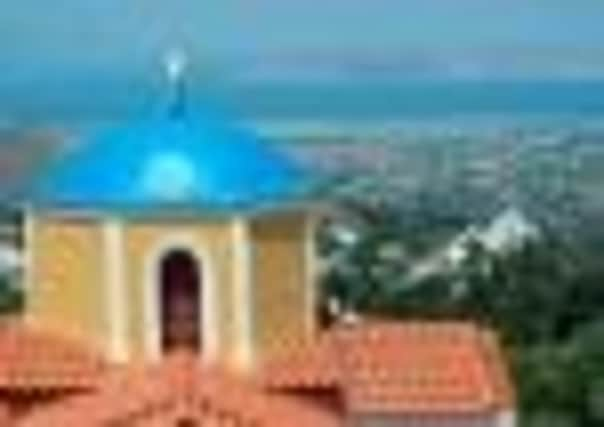Tides of history


We had taken shelter from the midday sun and were now sipping local wine in a shady, olive tree-fringed taverna in Zia, one of the highest villages on the Dikaios mountain region of Kos. It was a welcome respite after climbing the narrow street, which only the bravest of drivers dared to negotiate. On the ascent, we’d passed vendors selling natural honey, olive wood bowls, homemade cinnamon syrup, herbs and spices, before coming across an ancient watermill, the oldest in Kos.
As we explored the narrow walkways peppered with painted houses, we saw figs – one of the main crops on the island, alongside grapes, almonds, olives and tomatoes – growing on the overhanging trees, and stopped to take in the breathtaking views of neighbouring islands Pserimos, Kalymnos and Plati, as well as the coast of Turkey, only a 20-minute catamaran ride away.
Advertisement
Hide AdAdvertisement
Hide AdIt was worth staying until the evening for the spectacular sunset, the sky turning into magnificent shades of orange and yellow. Not only were the views amazing but the food was also wonderfully traditional, as restaurants serve up local delicacies ranging from octopus to mouth-watering lamb, slow cooked in clay ovens.
Tourism may have affected Kos in the last 40 years, as holidaymakers have taken advantage of its many beach resorts and the warm Aegean Sea, but the island retains a charm all of its own with its friendly Koans and relaxed ambience, particularly in the mountain regions.
Just 42km long and 8km wide, Kos is the third-largest island of the Dodecanese archipelago, after Rhodes and Karpathos, and sandwiched between the islands of Kalymnos and Nisyros. In Zia, we experienced the simple life at its finest. But, like many holidaymakers, we were also after a slice of luxury, and we found it at the brand new Thomson five-star Blue Lagoon Village in the south east, just a 10-minute drive from the airport.
The beach-fronted resort is a haven for those who really want to get away from it all – the closest town, Kefalos, is 7km away, while the nearest popular beach is Paradise Beach, two miles north. Kids’ clubs and activities abound, however, at the all-inclusive Blue Lagoon, which has myriad pools and restaurants, a challenging high ropes course, water slides in its own adventure area, tennis courts, a football pitch, gym and spa. The hotel even provides golf buggies to transport guests from one section of the complex to another. We had the ultimate luxury, an executive suite with our own personal pool, where a cooling swim at sundown provided a perfect end to our busy days.
Advertisement
Hide AdAdvertisement
Hide AdThe island houses a hotchpotch of history, from the traces of the Hellenistic period and the Roman years, to the buildings of Ottoman times, Byzantine churches, medieval castles, mosques and minarets. Hippocrates, the father of medicine, was born on Kos around 460BC, but the most important archaeological site is that of Asclepion, a large area of ancient ruins which was a shrine to Asclepius, the Greek god of healing, and a sanctuary from 500BC to 500AD.
People came from all over the ancient world to visit the Asclepion’s doctors, to use the healing centre and pray. Even today there’s a serene ambience. It’s amazing that so many relics have remained, considering the earthquakes which the island has experienced, the most catastrophic of which was in 1933, when many buildings fell, only to expose more ancient architectural treasures.
My family’s history tour started in Kos Town, the island’s capital in the north east, with its imposing 14th century Neratzia Castle, built by the Knights of St John to defend the island from marauders. At the entrance is the famous plane tree of Hippocrates, supposedly the oldest tree in Europe, measuring 10 metres in diameter. Legend has it that Hippocrates taught many of his pupils under the welcoming shade of its branches.
We wandered around the old town, with its narrow cobbled streets opening on to pretty squares, the largest of which is home to the Archaeological Museum and the restored Defterdar Mosque. In search of local produce, we marvelled at the municipal market, with its vast array of nuts, spices, Turkish delight and baklavas.
Advertisement
Hide AdAdvertisement
Hide AdThe nearby harbour was awash with excursion boats and vendors competing to offer the best deals on trips to neighbouring islands and to the Bodrum coast of mainland Turkey.
When we’d had our fill of history, we headed for the more serene setting of Agios Fokas a few kilometres south of Kos Town, for a therapeutic splash at Thermes beach, a sea pool where warm seawater meets natural hot mineral water springs. Having a dip there is said to alleviate the symptoms of rheumatism and arthritis.
Driving home to the other side of the island was a cinch. One main road stretching from one end to the other allows you to cover Kos in just an hour.
Small, sometimes hand-written signposts lead the visitor off the beaten track, down winding roads to the less commercial beaches.
Advertisement
Hide AdAdvertisement
Hide AdIn the south-west we discovered two beautiful, unspoilt bays divided by a promontory at Limnionas, one perfect for snorkelling amid the rocks, the other a shallow sandy bay next to a tiny harbour where Greek fishing boats were moored.
Further up the coast, near the busier resort of Mastihari, we ventured to Tam Tam Beach – not listed on any of the maps – to swim in the clear blue waters and enjoy a delicious meze at the only taverna there.
Getting there
Hannah Stephenson travelled with Thomson to the Blue Lagoon Village. Thomson offers seven-night all-inclusives at its Thomson Family Resort, the Blue Lagoon Village, from £899 per adult and £660 for first child and £755 for second. Thomson reservations: 0871 231 5595 or www.thomson.co.uk